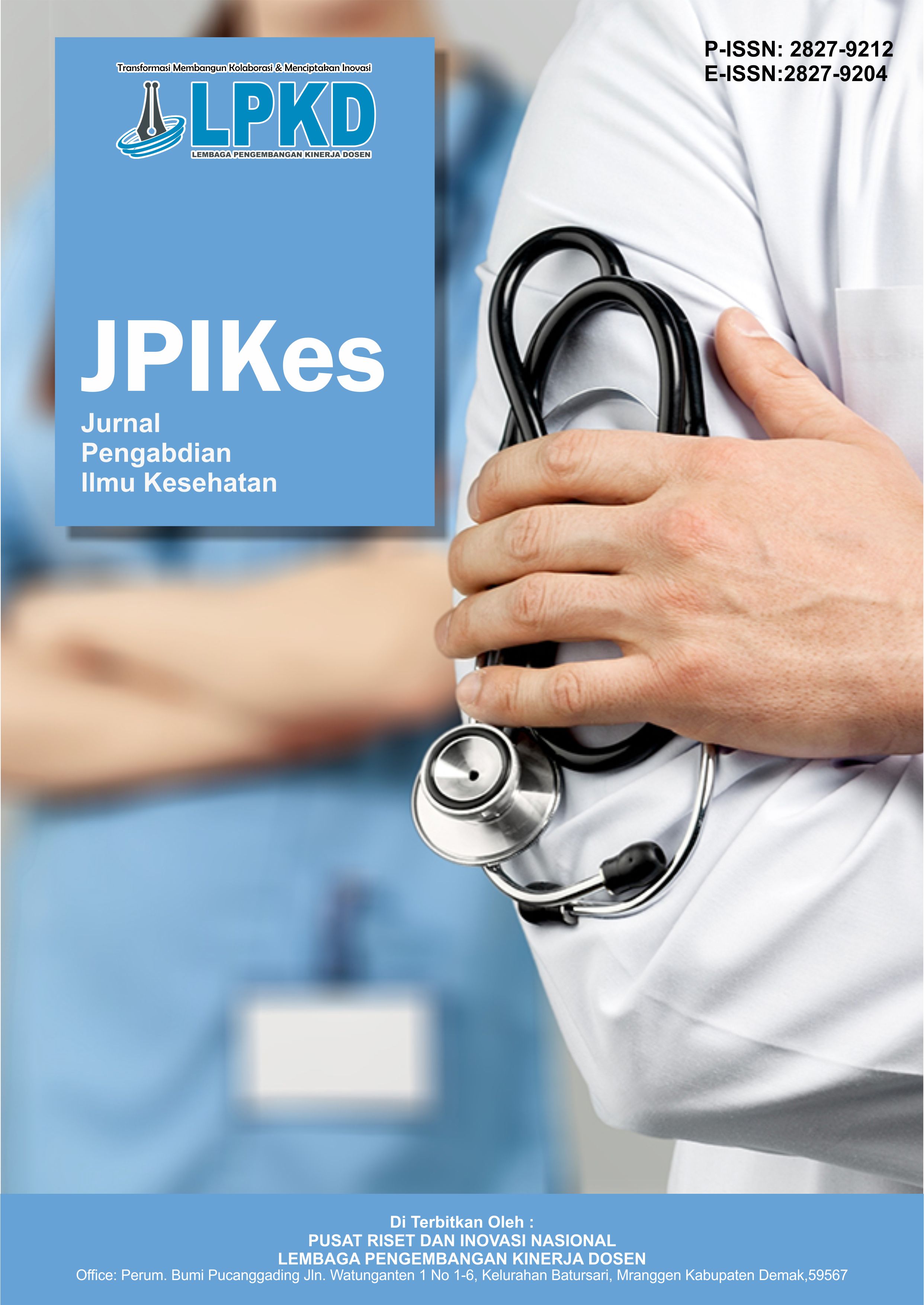Sosialisasi Penyakit Diabetes Mellitus untuk Meningkatkan Pengetahuan Pasien
DOI:
https://doi.org/10.55606/jpikes.v5i3.5929Keywords:
Diabetes Mellitus, Family Knowledge, Health Education, Prevention, SocializationAbstract
Diabetes mellitus (DM) is a non-communicable disease with a globally increasing prevalence, representing a major public health concern in the 21st century. This community service aimed to conduct a diabetes mellitus socialization program to enhance family members’ knowledge about the disease. Limited knowledge among the public often leads to delayed diagnosis, inadequate management, and higher risk of complications. A participatory approach and health education method were applied, emphasizing contextual, sustainable, evidence-based, and gender-sensitive principles. The program involved several stages, including stakeholder coordination, baseline surveys, needs assessment, development and delivery of training materials, and final evaluation. A total of 25 participants from families of diabetes patients at Dr. Sosodoro Djatikoesomo Bojonegoro Hospital took part in the program. Findings revealed that the intervention significantly improved participants’ knowledge, with an average score increase of 25.4 points or 52.7% from the pre-test (p < 0.001). Knowledge distribution shifted positively from a majority in the poor category (68%) to the fair-to-good category (92%). The greatest improvement was found in diabetes complications (36.4 points), followed by diabetes management (34.1 points), and diabetes symptoms (13.6 points). Participants’ satisfaction reached 100%, with 96% reporting being very satisfied. Interactive learning through discussion sessions proved effective in transferring knowledge and correcting misconceptions.
Downloads
References
Arimond, M., Wiesmann, D., Becquey, E., Carriquiry, A., Daniels, M. C., Deitchler, M., ... & Martin‐Prevel, Y. (2011). Dietary diversity as a measure of the micronutrient adequacy of women's diets in resource‐poor areas: summary of results from five sites. Washington, DC: FHI, 360.
Becker, G. S. (1964). Human Capital: A Theoretical and Empirical Analysis, with Special Reference to Education. University of Chicago Press.
Bhutta, Z. A., Das, J. K., Rizvi, A., Gaffey, M. F., Walker, N., Horton, S., ... & Black, R. E. (2013). Evidence-based interventions for improvement of maternal and child nutrition: what can be done and at what cost? The lancet, 382(9890), 452-477.
Black, R. E., Victora, C. G., Walker, S. P., Bhutta, Z. A., Christian, P., De Onis, M., ... & Uauy, R. (2013). Maternal and child undernutrition and overweight in low-income and middle-income countries. The lancet, 382(9890), 427-451.
Boyer, E. L. (1996). The scholarship of engagement. Bulletin of the American Academy of Arts and Sciences, 49(7), 18-33.
Coleman, J. S. (1988). Social capital in the creation of human capital. American journal of sociology, 94, S95-S120.
Cousins, J. B., & Earl, L. M. (1992). The case for participatory evaluation. Educational evaluation and policy analysis, 14(4), 397-418.
Cumming, O., & Cairncross, S. (2016). Can water, sanitation and hygiene help eliminate stunting? Current evidence and policy implications. Maternal & child nutrition, 12, 91-105.
Gillespie, S., Haddad, L., Mannar, V., Menon, P., Nisbett, N., & Maternal and Child Nutrition Study Group. (2013). The politics of reducing malnutrition: building commitment and accelerating progress. The lancet, 382(9891), 552-569.
Humas Pemerintah Kabupaten Paser, 2024. "Tahun 2024, 47 Desa Di Paser Jadi Lokus Stunting."
Humphrey, J. H. (2009). Child undernutrition, tropical enteropathy, toilets, and handwashing. The lancet, 374(9694), 1032-1035.
Kania, J., & Kramer, M. (2011). Collective impact. Stanford Social Innovation Review, 9(1), 36-41.
Media Kaltim, 2025. "Stunting di Paser Capai 2.385 Kasus, Pemkab Tetap Fokus Penanganan."
Niaga.Asia, 2024. "Ketidaksetaraan dan Keberagaman Kondisi Sosial Ekonomi Menjadi Faktor Meningkatnya Kasus Stunting."
Pemerintah Provinsi Kalimantan Timur, 2024. "Kaltim Berhasil Turunkan Angka Stunting Hingga 18,3 Persen."
Prado, E. L., Sebayang, S. K., Apriatni, M., Adawiyah, S. R., Hidayati, N., Islamiyah, A., ... & Shankar, A. H. (2019). Maternal multiple micronutrient supplementation and other biomedical and socioenvironmental influences on children's cognition at age 9–12 years in Indonesia. The lancet global health, 7(6), e772-e783.
Putnam, R. D. (1995). Bowling alone: America's declining social capital. Journal of democracy, 6(1), 65-78.
Ruel, M. T., & Alderman, H. (2013). Nutrition-sensitive interventions and programmes: how can they help to accelerate progress in improving maternal and child nutrition? The lancet, 382(9891), 536-551.
Ruel, M. T., Quisumbing, A. R., & Balagamwala, M. (2018). Nutrition-sensitive agriculture: What have we learned so far? Global food security, 17, 128-153.
Schultz, T. W. (1961). Investment in human capital. The American economic review, 51(1), 1-17.
Stewart, C. P., Iannotti, L., Dewey, K. G., Michaelsen, K. F., & Onyango, A. W. (2013). Contextualising complementary feeding in a broader framework for stunting prevention. Maternal & child nutrition, 9, 27-40.
UNICEF. (2013). Improving child nutrition: The achievable imperative for global progress. United Nations Children's Fund.
WHO. (2014). Global nutrition targets 2025: Policy brief series. World Health Organization.
Wikipedia, 2024. "Tanah Grogot, Paser - Ensiklopedia Bebas Indonesia."
Yenti, 2025. "Analisis Implementasi Kebijakan Percepatan Penurunan Stunting di Kabupaten Paser, Kalimantan Timur." Jurnal Reformasi Administrasi.
Yunus, M. (2007). Creating a world without poverty: Social business and the future of capitalism. PublicAffairs.
Downloads
Published
How to Cite
Issue
Section
License
Copyright (c) 2025 Jurnal Pengabdian Ilmu Kesehatan

This work is licensed under a Creative Commons Attribution-ShareAlike 4.0 International License.









